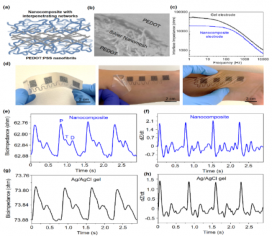Monitoring Cardiovascular Conditions with Flexible Sensing Devices
Researchers are making significant strides in developing flexible and lightweight wearable devices for continuously monitoring health conditions from the skin surface, substantially increasing the potential to detect abnormalities or early stages of diseases in the future. This work is being supported by the NSF-funded Precise Advanced Technologies and Health Systems for Underserved Populations (PATHS-UP) Engineering Research Center, headquartered at Texas A&M University (TAMU), as part of its mission to change the paradigm for the health of underserved populations.
Without accessible, inexpensive diagnostic tools, people in underserved communities will continue to experience more death, chronic disease, disability, and poor quality of life. PATHS-UP’s mission is to engineer transformative, robust, and affordable technologies and systems to improve healthcare access, enhance service and life quality, and reduce healthcare costs in underserved populations while recruiting and educating scientists and engineers to work toward a better future. Wearable electronic devices have the potential to bridge the healthcare gap but require materials with high conductivity, electromechanical stability, and physical properties comparable to human skin. For this research effort, the PATHS-UP TEAM designed and developed soft, stretchable, and breathable conductive nanocomposites (smart-engineered materials used in flexible electronics) that can offer superior monitoring of cardiovascular and other disease biomarkers at the point of care.
Recent advances in bioelectronics have led to a broad class of skin-inspired soft and stretchable electronic devices based on functional nanomaterials that can measure various biophysical and biochemical signals associated with health and disease. Conductive nanocomposites have shown great promise as a building block of these devices, but achieving sufficient conductivity, electromechanical stability, and skin-like properties has been challenging. In this project, the PATHS-UP researchers developed a moldable, transferrable, high-performance conductive nanocomposite comprised of an interpenetrating network of silver nanowires and poly(3,4-ethylene dioxythiophene): poly(styrene sulfonate). The stacked structure of the nanocomposite synergistically integrates the complementary electrical and mechanical properties of the individual components. The nanocomposites were patterned via a simple, low-cost micromolding process and then transferred the patterned large-area electrodes onto various substrates to realize soft, skin-interfaced electrophysiological sensors. Electrophysiological signals measured using the nanocomposite electrodes exhibit a higher signal-to-noise ratio than standard gel electrodes. This nanocomposite design and fabrication approach can be broadly employed for soft and stretchable electronic devices.



